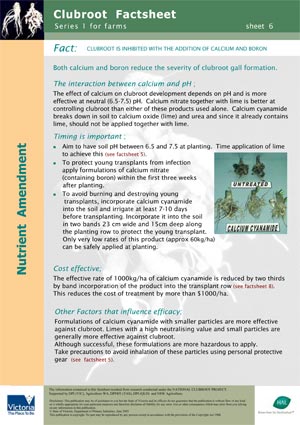|
Clubroot is the most serious soilborne disease affecting brassicas world wide.
Clubroot is caused by Plasmodiophora brassicae Woronin, an obligate biotrophic parasite.
Australian crop losses are estimated at between 5 and 10% of production.
Clubroot is endemic in most of the major production regions of Victoria, New South Wales and
Tasmania.
FACT : Clubroot is inhibited by the addition of Calcium and Boron
Authors
|
Caroline Donald
|
Ian Porter
|
Josie Lawrence
|
Barbara Czernaikowski
|
Rachel Lancaster
|
Dean Metcalf
|
Leigh James
|
Peter Stephens
|
Shane Dullahide
|


Calcium and pH
-
The effect of calcium on clubroot development depends on pH and is more effective at neutral (pH 6.5-7.5).
-
Calcium nitrate together with lime is better at controlling clubroot than either of these products used alone.
-
Calcium cyanamide breaks down in soil to calcium oxide (lime) and urea and should not be applied together with lime.
Timing is important
-
Aim to have soil pH between 6.5 and 7.5 at planting.
-
Time application of lime to achieve this
-
To protect young transplants from infection apply formulations of calcium nitrate (containing boron) within the first three weeks after planting.
-
To avoid burning and destroying young transplants, incorporate calcium cyanamide into the soil and irrigate at least 7-10 days before transplanting.
-
Incorporate it into the soil in two bands 23 cm wide and 15cm deep along the planting row to protect the young transplant.
-
Only very low rates of this product (approx 60kg/ha) can be safely applied at planting.
Cost effective
Other Factors
-
Formulations of calcium cyanamide with smaller particles are more effective against clubroot.
-
Limes with a high neutralising value and small particles are generally more effective against clubroot.
-
Although successful, these formulations are more hazardous to apply.
-
Take precautions to avoid inhalation of these particles using personal protective gear
Acknowlegements:
Financial support for this research has been provided by: Horticulture Australia Limited, the vegetable
growers R&D levy and Stae Departments of Agriculture.
Thanks to the following growers for their assistance with trial work:
| Con Ballan |
Geoff Cochrane |
Anthony Mason |
| David Milburn |
George Sabo |
Tony Wright |
| Sam Calameri |
Tom Winfield |
Andrew Doran |
| Mark Kable |
Kevin Temple |
Rod
Sherriff |
| Michael Camenzuli |
WU Yue Fang, |
ZHONE Cai Xia |
| Ha Sau Ying |
XIANG Cai Ji |
Robert Quirks |
| Dario Semenzin |
Harslett farms |
Greg Widderick |
Thanks to the following for their technical assistance on the project:
| Josie Lawrence |
Barbara
Czernaikowski |
| David Tooke |
Lisa Gibson |
| Jenny McGough |
Christina Bakker |
| Chang You Pan |
Kevin Lai |
| Alison Anderson |
Glenn Geitz |
| R. Palmer |
Kathy
McLachan |
| David Richard |
Duncan Cameron |
|
C. Haase
|
|
Statistical advice by Fiona Thomson and Nam Ky Nguyen (Department of Primary Industries, Vic).
|

